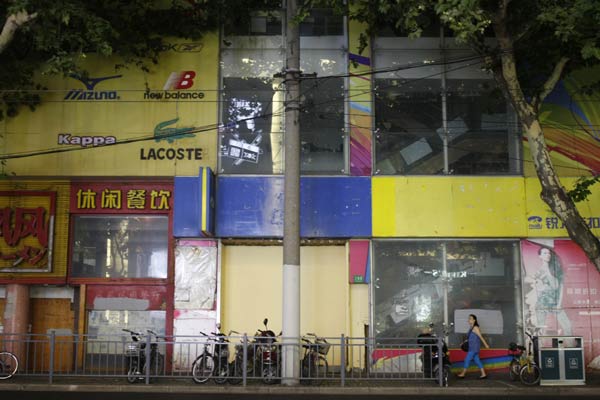 |
|
A pedestrian passes by a row of shuttered shops along Huaihai Road in Shanghai. Gao Erqiang / China Daily |
As a well-known shopping street loses flagship stores, it must transform itself to retain tenants and attract customers, reports Wu Yiyao in Shanghai
Huaihai Road used to be one of the busiest streets in Shanghai, with shoppers flocking to Japanese shopping mall Isetan, Mattel's Barbie flagship store and electronic home appliances retailer Media Mart, along with numerous shops for jewelry and watches.
Yet in the past few months, business seems to have turned sluggish, with many brands, including the above big names, having retreated from the 5.5-kilometer street.
In a 1-km section between South Chongqing Road and Sinan Road, more than 20 stores have closed, including a wedding gown purveyor, watch retailers, a home appliance hypermarket and fast fashion stores.
"I have never seen so many 'final sale' posters on Huaihai Road," said Zheng Shuqi, a 56-year-old resident. "I just don't understand it. It is such a prestigious location, why would a store choose to leave?".
|
 |
|
 |
Soaring rents may be one reason.
Daily store rents on Huaihai Road average between 35 yuan ($5.60) and 65 yuan per square meter, according to property consultancy firm Savills China. But compared with such retailing hubs as East Nanjing Road and Xujiahui, these rates are still relatively low, according to market insiders.
Zhen Shiqi, director of retail services for DTZ China, said the tenants' departures reflect a structural transformation for Shanghai's high streets. "There is a dire need for the streets to adapt to change," he said.
Zhang Xiaolu, a 26-year-old shopper, said Huaihai Road needs to improve its parking situation. It is too hard to find a place to park along the street, she said.
In addition, only two subway stations serve Huaihai Road. Shoppers have to walk for at least 10minutes from the nearest bus stop or subway station to reach the stores.
"People no longer want to walk a long distance to go to a store. That time has long passed. Now, people like to take the subway or even drive to where they go shopping. If it is too much trouble, they will buy online," said Zhang.
Wu Hesheng, head of Shanghai Huaihai Commercial (Group) Co Ltd, which leases many of the stores on Huaihai Road, said tenants moving in and out is "a cycle that every high street experiences".
"Stores choose their locations based on their business strategies," he said. Some have moved out to focus on online sales, others to cut costs and some simply to avoid competition. But other brands are considering moving in, Wu said.
Meanwhile, some stores on Huaihai Road have retained their popularity with locals - elderly shoppers still line up at the Guangmingcun food store that sells snacks such as fresh pork mooncakes.
